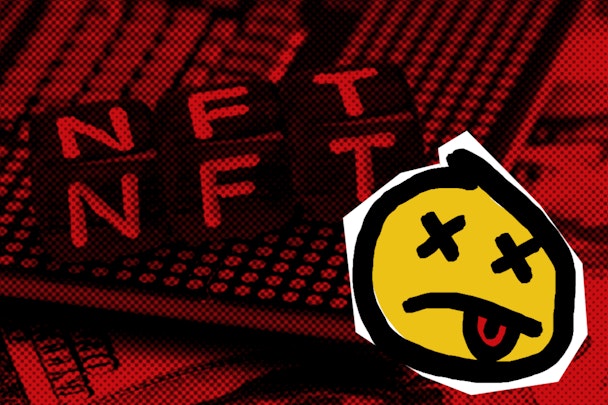NFTs aren't dead for brands yet. Welcome to NFT 2.0
Non-fungible tokens (NFTs) have had an interesting year: dizzying heights followed, recently, by a significant fall. Where will the NFT story take us next? Jellyfish's senior brand strategist James Croft investigates the current and future opportunities for brands.

As disruption and uncertainty surrounds the NFT space, Jellyfish questions its future.
The NFT space has experienced a turbulent few months. Weekly non-fungible token (NFT) sales fell 92% to 19,000 - down from a peak back in September 2021 of 225,000.
The hype and speculation in this space have significantly cooled off. The dramatic plunge in value at auction of the infamous Jack Dorsey Tweet NFT marks a significant stage in the evolution of NFTs.
What opportunity then remains for brands in this space? Patience and open-mindedness are teaching us a key lesson. Creating NFTs for the sake of it without considering the value added for consumers is flawed. When the dust settles, though, the fast-paced evolution of this space is already creating opportunities for a utilitarian and audience-centric experience - something I believe brands can get behind.
Disillusionment, enlightenment and 'speculative nothingness'
Mitch Lacsamana, head of marketing at Metaverse HQ summed up recently for Forbes what I’ve been thinking for a while about NFT drops like the Jack Dorsey Tweet NFT: “What is the utility of that NFT? Does Jack Dorsey take you out to dinner in Silicon Valley? What is the real value proposition here? I think time has probably told us, and it's probably nothing.”
One benefit I see in the recent shake-up of the NFT market will be the weeding out of many band-wagon projects which will be seen for what they truly are - speculative nothingness.
The feeling of disillusionment has set in, but we shouldn’t be surprised. The theory predicts such a dip. On the current Gartner Hype Cycle trajectory, we find ourselves in the trough of disillusionment. The question is: when and how will we enter a phase of enlightenment?
NFT 2.0
Ben Arnon, co-founder of NFT platform Curio explains that NFT 2.0 is already replacing what many have come to understand as ‘NFTs’; “NFT 1.0 was built on FOMO, [fear-of-missing-out] scarcity, and price appreciation." This original concept, he says, "saw NFTs as a digital version of licensed merchandise, which simply gave fans a way to show their affinity for a brand or flex their ownership of a limited edition. NFT 2.0 is set to be about utility, value, innovation, and storytelling.”
If NFT 1.0 was defined by immutable assets fixed on the blockchain, NFT 2.0 creates the ability to evolve, link, and interact with them, opening the door to utility-driven cases. These are also sometimes referred to as utility NFTs.
It’s no surprise that Bored Ape Yacht Club, the project synonymous with the NFT gold rush, is looking at ways to add new perks, features and benefits for owners to evolve their community into a longer-term 2.0 vision.
As a caffeine lover, the Crypto Barista project caught my eye. They are creating a hybrid loyalty-membership-slash-investor-opportunity that includes access to a lifetime of coffee perks and voting rights in the Barista Bank through the purchase of one of their NFTs. The vision of the project is; “...beyond digital artwork. The project aims to build a community of like-minded individuals who appreciate art, caffeine, entrepreneurship, and innovation within the coffee space.”
The brand opportunity
The idea of a collective of like-minded individuals feels like a real user case example that brands can tap into to build loyalty and involved, audience experiences where an NFT grants access to an ecosystem.
From my desktop research I wasn’t able to track down a brand doing this in its entirety (yet). Burger King has been exploring how to leverage NFTs as a customer engagement tool; as part of its Keep It Real Meals campaign, customers could scan QR codes and receive collectible NFT pieces toward other rewards. What I couldn’t see in this instance was a longer-term vision of fostering customer loyalty.
Starbucks may lead the way as it gears up to launch its NFT loyalty program, likely to replace or complement its existing program. The exact details are still to be revealed this year.
These examples all see beyond NFTs purely as a revenue-generating means, to a platform for utility creation and audience engagement. Equally, giving NFTs away (or including them with a small purchase) removes the volatile speculation that has fueled the bubble to date.
This cooling-off period isn’t a bad thing. It is a wake-up call driving the NFT evolution. Audience engagement may be just one example of many to come, but it offers a real vision of what the future opportunity is for brands. The immutable and speculative nature of NFT 1.0 is driving an enlightened 2.0 focus on utility and added value, is an important step to forging a future in this space.
Content by The Drum Network member:

Jellyfish
Jellyfish is a marketing performance company for the platform world, where success demands a creative, multi-platform mindset. We help brands thrive, by navigating,...
Find out more
